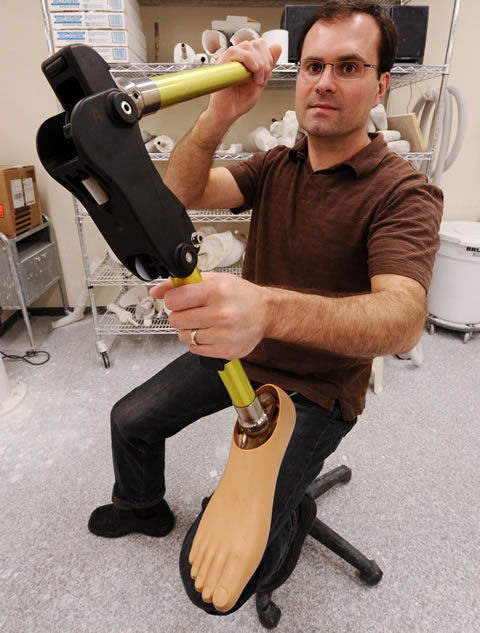For most people, the cheapest way to get from here to there is to walk. But for millions around the world who have lost a leg, a high-quality prosthetic limb costs more than they can afford. The ability to walk is simply out of their price range.
This situation is changing, though, thanks to a prototype for a low-cost prosthesis that not only matches the functions of more expensive technologies, but also is more robust and versatile.
The leg’s developer, Jan Andrysek, is a professor at the Institute of Biomaterials and Biomedical Engineering. While current state-of-the-art limbs costs more than $3,000, Andrysek predicts his will cost $100 or even less when it goes into widespread production. His innovation is a patented knee-joint mechanism that automatically locks when the owner rests weight on it, and unlocks with forward movement. It acts much like a biological knee. This simple, inexpensive device matches many of the functionalities of high-end limbs that are packed with hydraulics, robotics and other costly technologies.
“There’s always an engineering solution to a technical problem if you make it complex enough,” Andrysek says. “But there are millions of people in low and medium-income countries, and the technologies that are accessible to them haven’t really changed much over the last 50 years. So why not look to see if we can improve the simple technologies as well?”
Simplicity not only makes the prosthesis more affordable, it also makes it more versatile. Andrysek’s technology can weather the elements in ways existing limbs cannot. He is working with the International Committee of the Red Cross to test the leg in several countries, including Tanzania and Chile, but he also sees a market for his invention in wealthier countries.
“[In developed nations] people usually get their primary prosthesis funded. But if they need a secondary one, then it’s out of their own pocket,” he says. “And you may need a secondary leg for activities where your leg gets wet or dirty. The technologies that are out there don’t do very well under those circumstances. Our technology is designed to be quite robust in water and dirt. There is a potential application as a ‘recreational leg’ that many amputees can use.”
Nobody takes to water and dirt more than children, and Andrysek believes the technology could be adapted for them as well. “It’s a bit of work to miniaturize the mechanism,” he says. “But the pediatric focus is definitely a direction we’re taking. It’s a need we’ve identified – to have a stable little knee that the kids don’t have to worry about destroying so easily. They can get it wet in a puddle and not worry about it.”
Visit Legworks for more information about Prof. Andrysek’s innovative prosthesis.
Improving Lives Through Low-cost Medical Technology from U of T Engineering on Vimeo.
Recent Posts
U of T’s 197th Birthday Quiz
Test your knowledge of all things U of T in honour of the university’s 197th anniversary on March 15!
Are Cold Plunges Good for You?
Research suggests they are, in three ways
Work Has Changed. So Have the Qualities of Good Leadership
Rapid shifts in everything from technology to employee expectations are pressuring leaders to constantly adapt







12 Responses to “ The $100 Artificial Leg ”
Great job! I wish that thousands people of Afghanistan that have lost their legs due to mines can benefit from this.
Keep up the good work. I like simplicity. Less likely to go wrong, less costly and more likely to actually serve the need.
This is great news. I know of someone in Trinidad and Tobago who could definitely benefit from this. Is there any plans for distribution to this country?
Very good work. This is what making a change is all about.
Sirs, I am India-based. Can anyone inform me how I can use this innovative low-cost limb?
@Gopi Sharma
The limb is still undergoing testing, but I understand that it will be made commercially available in the next year. For more information, contact the Bloorview Research Institute in Toronto.
if you need a guinea pig to practice on I'll be a candidate!
I am hopeful that people who are unable to pay the regular cost of a prosthesis will benefit from this. I know I can get one for a reasonable price due to government aid, but still I am very much interested in your product
Is this leg currently available?
@PatSullivan
The knee (called the All-Terrain knee) is now available through http://legworks.com/. Contact information is provided on the website.
Email: sales [at] legworks [dot] com
My name is Rogério. A friend of mine had one of his legs amputated recently. His friends are trying to help him, and he will need an artificial leg. How much does one of these legs cost?
@Rogerio:
The knee (called the All-Terrain knee) is now available through Legworks. Contact information is provided on the website.
Email: sales [at] legworks [dot] com